Recently, I shared with my team my dad’s trick of using baling wire to secure cans of Van Camp’s Pork and Beans to the manifold of our work trucks. The paper labels were first removed from the cans, of course, and we had to open the cans and eat from them wearing work gloves. But that didn’t matter. We had hot lunch.
That trick works on the ’50s-era trucks my father favored but not so well on modern vehicles. “Today, when you look under a hood, all you see is plastic and metal shields covering an engine,” remarks Rhode Island builder Mike Guertin. “The ’50s and ’60s trucks had so much room around the motor, you could practically roast a whole hog off a straight-six manifold.”
Metal Drum, Dashboard, or Portable Warmer
Guertin once rigged up a 55-gallon drum with one end cut open and a piece of 6-inch duct as a short chimney at the other. “Stoked with cutoffs (no precut studs at the time), we’d keep it going all day during winter. At breaks, it kept us warm inside and out. [We’d cook] grilled sandwiches, foil-wrapped potatoes in the coals, hot soup in an old pot or a can resting on top the woodstove.”
Big Crew Cooking
There’re a lot of “content creators” in the homebuilding space who make a lot of suspicious content straddling both DIY and contractor audiences. Selling “merch” is usually the step-too-far that drives me away. The folk at Haus Plans, however, are a bit different. They’re doing serious spec-home building (and appear to be having a lot of fun doing so). But it’s their jobsite cooking that’s astounding. Better have a big crew for lunch when you follow their recipes, because these folks aren’t messing around with portions.
–CDK (with an assist from Paul Makovsky)
Guertin also introduced us to the “microdash”—an oven of sorts that a crew member he once worked with made out of a piece of foil-lined lumber fit between the dashboard and windshield. With his windshield facing south, this crew member would heat up whatever he’d packed for lunch, Guertin recounts. “Usually a sandwich but sometimes soup. He’d put his food and left-over morning coffee in the ‘microdash’ an hour before lunch and enjoy a hot meal, provided the sun was shining.”
Pennsylvania builder Mark Clement is adamant about preparing healthy, hot meals for work. Clement argues his body is the best tool he owns, and he recalls former Tools of the Trade editor Rick Schwolsky’s comparison of career builders to professional athletes. When you’re in it for the long haul, it’s wise to watch your diet, Clement urges. “Pasta, bagels, salad dressing … They’re the reason that bending over becomes a Herculean experience,” he quips. “Eggs. Meat. Fruit. Vegetables. That’s firepower …”
“I just spent three weeks on the Extreme Makeover: Home Edition set as a project manager,” Clement adds, “and while craft services [the department on a film set that provides food and drinks to the cast and crew] existed, it was just OK … Brownies are fun, but my shift is 14 hours. Food is fuel.”
Back in his home state, Clement “cooks” on the jobsite in a small food warmer (see photo above). “It’s a soft-sided insulated bag with a heating element inside,” he explains. “By placing the meal in a glass-bottom storage container with a snap-on, gasketed plastic lid, I plug that puppy in when I get to work and, in a few hours, I have piping hot food.”
To make that work more efficiently, Clement “meal preps” once a week at home. “I can make eight to 10 meals in the exact same time it takes me to make one. I box them up and yank one out of the fridge as I walk out the door.”
Site-Made Cold Storage
Missouri builder Jake Bruton and crew regularly lean on a hot plate to wrangle up hot lunch. A companion to the hot plate in his jobsite kitchen is the cooler one of his project managers made out of scraps of Zip System R-Sheathing (see photo below). This has worked so well, that project manager now assigns making a Zip-R cooler to all his new hires. It doubles as a skill-building exercise. How cool is that?

Jake Bruton
